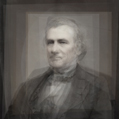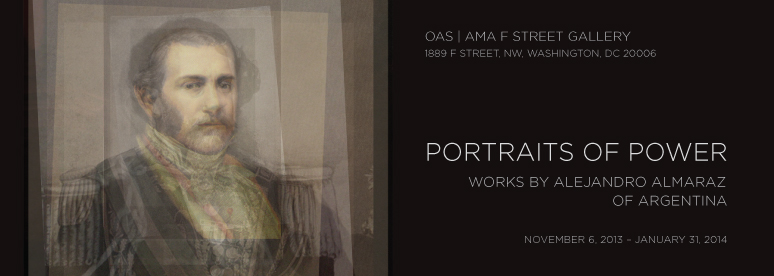F STREET GALLERY EXHIBITION - 1889 F Street, NW

Opening Remarks by
Dr. Kevin Casas-Zamora, OAS Secretary for Political Affairs
I want to commend Alejandro Almaraz and the organizers of this exhibit for giving us a very good opportunity to reflect on the transient nature of power, on the complex relationship between the individual and institutions, and on the importance of context when discussing power.
I’m going to mention a few things that struck me about the portraits. The first one is how they dissolve individual traits, in such a way that the end result is a face that belongs to no one in particular. Such is, I’m afraid, the nature of power, which by virtue of its logic and demands, makes people behave, pose, and look in a certain way. Political leaders like to think that they make and change the office they hold. In fact, it is just as true that the office makes the person. One only has to think about the acute dilemmas faced by someone like President Obama in dealing with U.S. national security. It is easy to oppose targeted assassination or Guantanamo when you’re running for President. Your perceptions will almost surely change once you’re in the Oval Office. The implacable demands that power places upon individuals blur differences.
But I would also add that the reason why individual traits largely vanish has much to do with the underlying homogeneity of the faces that comprise each portrait. Those faces are largely similar. One of the virtues of this technique is precisely that it allows us to spot those who are truly different. One of the lessons that emerges from these pictures is how extraordinarily difficult in all cultures is to get to the pinnacle of political power if you are different -- really, really different. That’s what makes Maggie Thatcher’s pearl necklace, which sticks out like a sore thumb, the most compelling detail in the whole collection. It is a reminder of what an exercise in misogyny political power has been across cultures. Bear in mind, also, that the last portrait of U.S Presidents covers until 2008. It would look very different had it covered until 2013. These portraits allow you to spot those leaders who are really different from the elites in their own societies. There are exceedingly few of those shown here.
The dissolution of individual traits that we see here is a tragedy for politicians, who like to think of themselves as unique and irreplaceable. Yet, I’m afraid these portraits are a rather faithful rendering of the way in which both history and public opinion operate. Pundits and political junkies like us are able to tell apart the faces that give life to politics, in the same way that historians would be able to unpack each of these pictures. For normal people, who don’t care that much for politics and public affairs, it is all a big blur in which politicians become indistinguishable and, generally, despised. One of the most sobering experiences of my time as Vice President of Costa Rica happened whenever I traveled to any place outside a radius of, say, 100 miles from the capital city, San Jose. My politician’s ego would be badly bruised by the end of the day because virtually none knew who I was. In my mind I was someone of consequence – Mr. Vice President. For the people I met I simply was another politician they distrusted.
Enough said about the blurring of faces. Now I would like to add a final word about the context. This is ostensibly a work about the alternation of power. The thing is that the multiple faces seen here tell only part of the story. The other part is to be found in the context in which all these transitions took place. It is that context that bestows meaning to alternation and ultimately grants to the faces the dignity that the authors of all these portraits tried so hard to convey. We have, on the one hand, the alternation seen in dictatorships, where the change in hapless and meaningless faces, is simply an instrument to protect the immutability of a regime – something that changes so that nothing changes, a – la – Lampedusa. And here my favorite example is the portrait of the heads of government of the former German Democratic Republic. They were part of the dustbin of history well before their political system went the same way. We also have the alternation that defines a revolutionary change, where a power structure is demolished and replaced by a new one, a process that inevitably brings pangs of birth, disillusionment and, perhaps, a few lasting victories. In between those extremes, we have the alternation of power that defines a democracy, that which is a manifestation of pluralism as well as a tangible sign of the notion that the minority opinion can at some point become the majority. This is the alternation that is, above all, a check on power, which becomes degraded and corrupt, like water, when still for a long time. Lord Acton told us this. It is this democratic alternation that’s deserves to be celebrated -- the one that breathes new air into politics, the one that means change in policies amidst continuity in principles, a continuity, moreover, that is not synonymous with immutability. That’s why there is an unspoken dignity in the portraits of the French Presidents, or the Presidents of the United States, or the Presidents of South Africa since 1994 that we won’t be able to find in the pictures of the rulers of North Korea or apartheid South Africa or the Soviet Union. The former leaders are what they are and belong to this story because of the free will of their fellow citizens; the latter are but the sad product of brute force and whatever twisted human impulse moves certain people to oppress their fellow human beings. Their blurring notwithstanding, the former portraits represent a triumph of freedom, embedded in a set of institutions committed to the protection of human dignity. The others are simply a collection of lesser faces on the road to oblivion.
Let me thank our colleagues of the Art Museum of the Americas for stimulating this discussion and congratulate, once again, Alejandro for giving us the privilege to see this wonderful collection of artworks.

